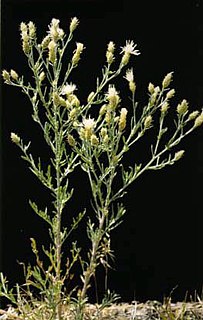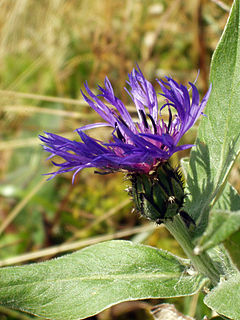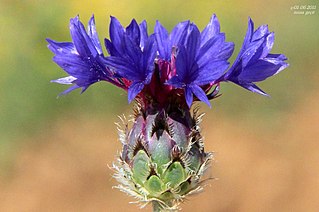
Centaurea is a genus of between 350 and 600 species of herbaceous thistle-like flowering plants in the family Asteraceae. Members of the genus are found only north of the equator, mostly in the Eastern Hemisphere; the Middle East and surrounding regions are particularly species-rich. In the western United States, yellow starthistles are an invasive species. Around the year 1850, seeds from the plant had arrived to the state of California. It is believed that those seeds came from South America.

Centaurea cyanus, commonly known as cornflower or bachelor's button, is an annual flowering plant in the family Asteraceae native to Europe. In the past, it often grew as a weed in cornfields, hence its name. It is now endangered in its native habitat by agricultural intensification, particularly by over-use of herbicides. However, Centaurea cyanus is now also naturalised in many other parts of the world, including North America and parts of Australia through introduction as an ornamental plant in gardens and as a seed contaminant in crop seeds.

Glebionis segetum is a species of flowering plant in the family Asteraceae, probably native only to the eastern Mediterranean region but now naturalized in western and northern Europe as well as China and parts of North America. Common names include corn marigold and corn daisy.

The Valley of Elah or Ella Valley, called in Arabic: وادي السنط, Wadi es-Sunt, is a long, shallow valley in Israel and the West Bank best known as the place described in the Old Testament where the Israelites were encamped when David fought Goliath. It is home to several important archaeological sites, including those identified as the ancient towns of Azekah and Socho (17:1). Rising up from the valley on its extreme southeast end lies the hilltop ruin Adullam, and on its north lie the ruins of the ancient fortress city of Khirbet Qeiyafa.

Centaurea diffusa, also known as diffuse knapweed, white knapweed or tumble knapweed, is a member of the genus Centaurea in the family Asteraceae. This species is common throughout western North America but is not actually native to the North American continent, but to the eastern Mediterranean.

Centaurea calcitrapa is a species of flowering plant known by several common names, including red star-thistle and purple starthistle. It is native to Europe but is rarely found there, it is known across the globe as an introduced species and often a noxious weed. The species name calcitrapa comes from the word caltrop, a type of weapon covered in sharp spikes.

Centaurea solstitialis, the yellow star-thistle, is a member of the family Asteraceae, native to the Mediterranean Basin region. The plant is also known as golden starthistle, yellow cockspur and St. Barnaby's thistle The plant is a thorny winter annual species in the knapweed genus.

Centaurea montana, the perennial cornflower, mountain cornflower, bachelor's button, montane knapweed or mountain bluet, is a species of flowering plant in the daisy family Asteraceae, endemic to Europe. It is widespread and common in the more southerly mountain ranges of Europe, but is rarer in the north. It escapes from gardens readily, and has thereby become established in the British Isles, Scandinavia and North America.
Protocyanin is an anthocyanin pigment that is responsible for the red colouration of roses, but in cornflowers is blue. The pigment was first isolated in 1913 from the blue cornflower, and the identical pigment was isolated from a red rose in 1915. The difference in colour had been explained as a difference in flower-petal pH, but the pigment in the blue cornflower has been shown to be a supermolecular pigment consisting of anthocyanin, flavone, one ferric ion, one magnesium and two calcium ions forming a copigmentation complex.

Rhaponticum, is a genus of flowering plants in the thistle tribe within the sunflower family.

Centaurea gymnocarpa, also known as fiordaliso di Capraia (Italian); centaury of Capraia/Caprian cornflower (English), is a species of flowering plant in the family Asteraceae. It is a rare species endemic to Italy found only on Capraia, a small island located in the Tuscan Archipelago, with the species being distributed across 8 subpopulations on the island's surface. Its natural habitats are Mediterranean-type shrubby vegetation and rocky areas, colonizing in the cracks and fissures of cliffs.
Chaetorellia australis is a species of tephritid fruit fly known as the yellow starthistle peacock fly. It is used as an agent of biological pest control against the noxious weed yellow starthistle.

Centaurea depressa, the low cornflower, is a species of Centaurea. It is native to southwestern and central Asia. Its common name is Iranian knapweed. The plant grows to 0.3 m (1 ft) tall and flowers from July to August. It can grow in nutritionally poor soil and is drought tolerant.

Psephellus dealbatus, the Persian cornflower or whitewash cornflower, is a species of Psephellus native to the Caucasus Mountains. It is widely cultivated as an ornamental perennial.

The Blue Oak Ranch Reserve, a unit of the University of California Natural Reserve System, is an ecological reserve and biological field station in Santa Clara County, California. It is located on 3,260 acres (13.2 km2) in the Diablo Range, northwest of Mount Hamilton, at 1,500 ft (460 m) elevation.

Jordanita chloros is a moth of the family Zygaenidae.

Centaurea stoebe, the spotted knapweed or panicled knapweed, is a species of Centaurea native to eastern Europe. It is also an invasive species in the United States, and particularly widespread in dryer regions of the West, which has a similarly dry climate as the Mediterranean. This species and Centaurea diffusa are tumbleweeds — plants that break free of their roots and tumble in the wind, facilitating the dispersal of their seeds.
Cornflower is a flowering annual plant Centaurea cyanus.















